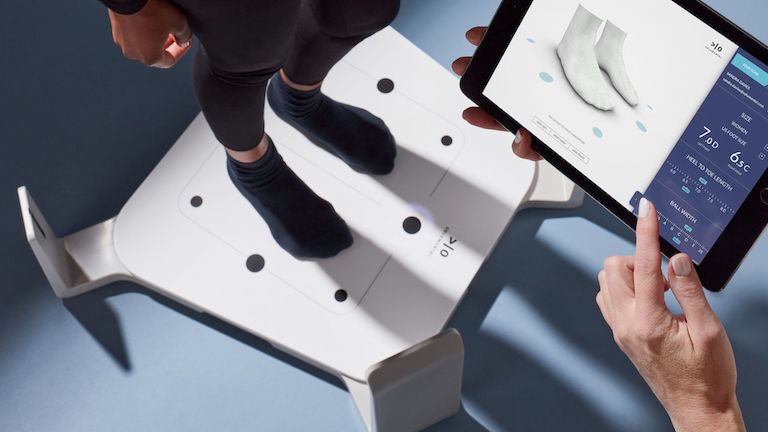Fashion Briefing: 3D printing is coming for footwear design and manufacturing
This week, we take a deep dive into 3D printing, as more footwear brands are making sustainable manufacturing a priority. 3D printing, seen on Paris Fashion Week runways, has been hailed as a business solution for footwear, one of the most waste-heavy areas of the fashion industry. Scroll down to use Glossy+ Comments, giving the Glossy+ community the opportunity to join discussions around industry topics.
Some of the biggest brands in footwear and fashion — including Adidas, Nike, New Balance, Dior, Reebok, Fendi and Pangaia — have launched limited-edition 3D-printed shoes in the last year. And some have been experimenting with the idea as far back as 2013. However, scaling the technology has not yet happened, with brands sticking to limited-edition collections rather than tackling full-scale supply chain implementation. That’s set to change, thanks to new businesses prepared to do production at a commercial scale.
“The shoe industry is the last bastion of complicated handmade stuff,” said Asher Clark, design director and co-founder at Vivobarefoot and a seventh-generation cobbler. Vivobarefoot is currently developing a next-generation footwear solution via a design customization platform and a 3D-printed shoe style, both launching next year.
“Over the past 18 months, there’s been a huge growth in awareness of 3D printing for footwear,” said Elias Stahl, co-founder and CEO of B2B 3D-printing company Hilos. “You’re seeing more 3D-printed shoes, some on the runway at Paris Fashion Week. What is missing is people actually scaling that into volumes that are commercially viable.” A number of brands, including Dior, KidSuper, Rains and Botter, showed 3D-printed shoes at PFW.
As 3D printing offers the ability to manufacture each pair of shoes on-demand, or at least manufacture fewer shoes, it’s attracting interest from brands wanting to eliminate waste. The process uses materials like TPU or polyurethane that are squeezed out of the 3D printing machine in a thin line of TPU/polyurethane following a digital 3D design. Typically, sneakers and footwear are made using molds. That even includes the 3D-look Yeezy Foam Runners, for which a foam material is pumped into the mold to create the final sole and upper.
Molds also produce waste. With 3D printing, the machine stops once the item is formed, and there is no excess. “Brands have to invest a quarter of a million dollars to open a mold. They don’t know how much of the product they’re going to sell, and then they can’t change it,” said Stahl. “Smaller luxury and fashion brands don’t tend to sell a lot of volume. They may have 600 different designs, but [they may only sell] a couple thousand pairs per design. Molds really constrain them.”
“If you can offer brands the ability to not only step outside [of those parameters] and iterate quickly, but also develop synthetic textures and material appearances that create a whole design language for each product, and in less than 30 days, that becomes very compelling,” said Stahl. Portland-based Hilos is currently teaming with mass athletic and outdoor brands, en route to commercializing 3D printing.
Although, like leather alternatives, current 3D-printing materials are not bio-based, bio resins are being explored by brands thinking long-term about 3D-design capabilities. But TPU and polyurethane can be melted down or downcycled into other items once worn through.
According to research company Technavio, the 3D-printed footwear market is estimated to grow at a compound annual growth rate of 19.7% between 2022 and 2027. The size of the market is expected to reach $1.97 billion in that time. The footwear industry has a big waste problem that 3D printing could solve: Twenty-three billion pairs of shoes are made every year and 22 billion are thrown into landfill, according to research company Statista.
3D-printing footwear start-up Zellerfeld launched its shoe 3D-printing platform in February. In April, it worked with Pangaia on the “Absolute Sneaker,” which launched online as a limited release in two colorways, each retailing for $250. The startup manufactures shoes on-demand through a B2B model, helping brands create their own 3D-printed styles. Each shoe can be customized to the wearer’s foot using a 3D scan taken with a smartphone. In July, it also worked with Moncler to launch an exclusive sneaker, only available to its community members, for the brand.
Other companies and brands are testing technologies and solutions that are similar to 3D printing, in that they allow for virtual try-on, accurate foot sizing and no-waste production. For its part, Hilos recently announced a $5 million investment round that included funding from longtime Nike executives. The company has also hired designers from Nike to showcase the level of designs and capabilities that are possible using 3D printing.
“3D design has got to be cost-competitive, at the end of the day,” said Stahl. “If it doesn’t make financial sense for a brand or retailer, it’s not going to be adopted at scale. But brands are both overproducing and missing out on sales, because often you go into a store or go online and the color and size you want is not in stock.” 3D-printed styles offered on-demand in-store will ensure shoppers get what they’re looking for.
“There’s an entire structure that’s incentivized by the current way things are done. If I’m a designer or a merchandiser, I don’t care about net profitability based on sell-through and liquidation, I care about gross margin.”
The start of a new footwear supply chain model?
For some brands, 3D printing is just the start of creating a new, fully immersive, technology-enabled footwear experience. “Nowadays, shoes are made in slow, analog, complex overseas supply chains, which are very industrial. But it’s still a wasteful process, and all of the shoes fit the same,” said Clark. “There’s also a huge pre-production environmental waste cost, as well as supply chain and manufacturing complexities at the front end and the back end.”
The Vivobarefoot Biome shoe, with its 3D-printed sole and 3D-knitted upper, will launch in the summer of 2024. It will be priced at $335 after a pilot phase closes in May 2024. Its Vivobiome technology platform allows customers to create an exact model of their foot through photo telemetry technology via the camera on their phone. They can also design the shoe and try it on with AR.
The company has worked with nine different partners to enable a connected experience throughout the shoes’ entire lifecycle. From sign-up to pre-order of the 3D-designed and -printed shoe, to delivery, and product disassembly at end of life, all elements are connected through the app. Each pair of shoes will have a digital twin, backed up on the blockchain. By 2024, the company is also working to complete nearshoring in Europe for all of its 3D printing and knitting operations. At the moment, some components of its 3D knitting are happening in China, with the 3D printing already being carried out in Europe.
Vivobarefoot is projected to close 2023 at $91 million in revenues, up from $65 million last year. The company has a global retail footprint, selling through wholesale partners and owned stores in countries from Canada to the U.K. to Japan. Its key markets are Europe, Australia and Japan.
The Vivobiome app will also engage users in the post-purchase journey by rewarding them when they engage with content and make progress in a “Pokemon Go,” treasure hunt-type game. “We’ve been live for about three weeks and we’ve had close to 18,000 global signups, mainly through our social media and Vivobarefoot customer community; about a third of our community has signed up,” said Clark. By using innovative concepts, including gamification, 3D printing, blockchain and made-to-order, Clark hopes to create the future of the footwear industry.
Inside our coverage
New federal retail data receives mixed reviews despite growth
Sneaker brand marketing 2.0 involves NFC tags and gaming partnerships





